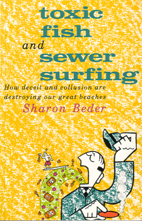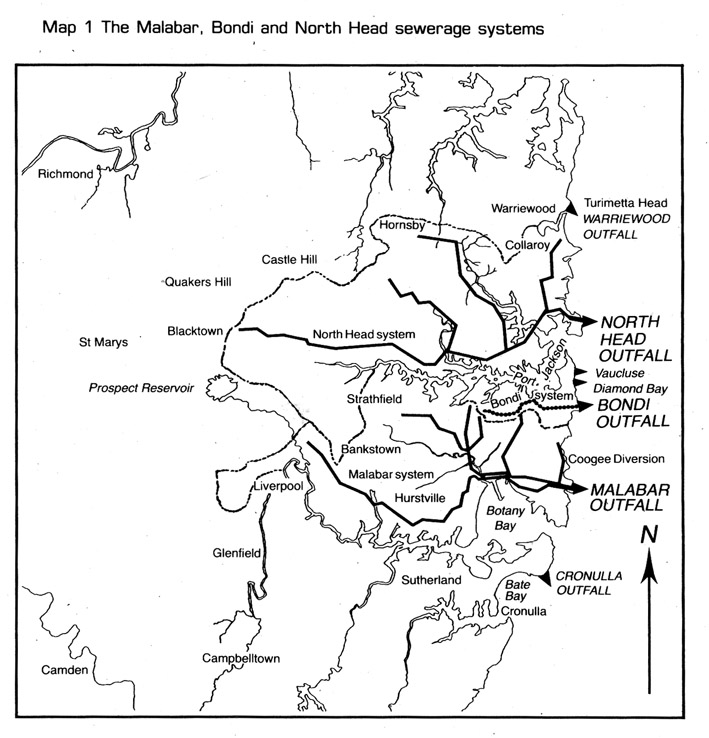
by Sharon Beder
first published by Allen & Unwin, Sydney, 1989
Introduction
Sewers seaward
Toothless watchdog
Toxic fish
Sewer-side surfing
Public relations battle
Events of 1989
Beyond Sydney
Conclusion
Bibliography
On Good Friday 1989, almost a quarter of a million people gathered at Bondi Beach for the ‘Turn Back the Tide’ concert, which was being staged as a protest against the pollution of Sydney's beaches. Some of Australia's leading singers and musicians were there. The weather was miserable, but this didn't stop the huge crowd from bellowing out its indignation as speakers from the stage condemned the authorities for allowing the beaches to deteriorate so badly.
In the weeks leading up to the concert, Sydneysiders had been stunned by a series of revelations about the condition of their beaches, the state of local fisheries, and the cover-ups by key government authorities. People no longer knew whether it was safe to go swimming, surf lifesavers threatened to walk of the job, the fishing industry began losing millions of dollars each week as people turned away from seafood in droves, and the politicians seemed incapable of doing anything about it.
The previous winter news of dying seals in the Baltic Sea and hospital waste washing up on New York beaches had a11 seemed so far away. People had asked whether such things could happen in Australia in years to come, little realising just how bad things already were. In the new year thousands of people turned out for the Big Clean, to help clean up Sydney Harbour. Many were amazed at what they found; that evening the television screens were filled with piles of syringes, dumped cars, and other assorted garbage collected during the day. Then, that very weekend, the Sydney Morning Herald carried a story that really rocked the city: fish caught in the ocean near one of Sydney’s main sewage outfalls had been contaminated with pesticides averaging more than 120 times recommended safety limits—pesticides that could cause cancer and perhaps harmful genetic effects. Worse still, two government authorities had kept these findings secret for more than a year. The Herald also reported that Hea1th Department surveys had found that many popular Sydney beaches were unsuitable for swimming for more than 30 per cent of the time (Herald, 7/1/89).
Suddenly sewage pollution became a topic of conversation at dinner parties. Everyone, it seemed, had stories of ear, nose and throat infections, and some even spoke of hepatitis and meningitis. By the following Thursday the Herald’s ‘Style’ supplement was cataloguing young professionals who had given up surfing. Susan Owens reported:
The love of Sydney's beaches dies hard. Those who fear to swim still make appearances, because going into the surf used to be a way of 1ife. Nowadays, new-wave beach-goers take a sarong instead of a beach towel (which they no longer need); a sun block and hat instead of an umbrella (because they no longer sit around). (Herald, 12/1/89)
The economic consequences became apparent to beach businesses and fish merchants over the next few months. Shops and businesses at Manly claimed their takings were down 15 per cent on the year before and the manager at the Bondi Beach Motel said his business was down 25 per cent on the previous year. A souvenir shop at Bondi, which had closed, painted a message on its window.
But the impact was wider than a few shops and hotels. Bondi Beach is said to be Australia's third largest tourist attraction. The news of Bondi's pollution travelled around the world and, in consequence, Australia's tourist industry may be affected for years to come.
The cost to the fishing industry is more easily quantified. Fish sales were down by 30–40 per cent and costing the industry a reported $500 000 each week in lost sales. Sydney fish restaurants also felt the impact as Sydney-siders became suspicious of seafood.
For the Water Board, the publication of these stories was nothing short of a disaster. The results of years of carefully planned public relations campaigns were in tatters. Public relations officers were screaming at reporters and later having to make apologies. Key employees were being struck down with stress-related illnesses.
For environmental groups like Stop the Ocean Pollution (STOP), the sudden interest in beach pollution was heaven-sent. They had been battling for years to have their concerns heard. Now they were being barraged by reporters eager for stories.
What had happened? The beaches weren’t really any worse that summer than other summers, although there had been a few bad days when illegal dumping had spoilt beaches up and down the coast. Perhaps people were more environmentally aware. More importantly, they had finally been told what the situation really was. This was information they had a right to, but it had been kept from them by the very authorities that were supposed to be acting in their interest—the Water Board, the State Pollution Control Commission, and the New South Wales Government.
The Water Board is in charge of sewage, which along with industrial waste is discharged into the ocean through three major outfalls at North Head, Bondi and Malabar (see Map 1). Each day more than a thousand million litres of waste (equivalent to about 25,000 average backyard swimming pools which would stretch from Sydney to Goulburn if put end to end) go through these outfalls. The sewage is minimally treated. Larger solids are screened out. Bondi and Malabar, which were de- signed for primary treatment, succeed in removing less than 20 per cent of suspended solids. At North Head, primary treatment was never even attempted.

The three main sewer lines and outfalls in Sydney are shown in this map
At the time of the Turn Back the Tide Concert the Sydney Water Board was in the final stages of constructing extended outfalls at each of these three major outfall sites, because it was obvious that the beaches were being polluted. The new outfalls will take the sewage between 1.5 and 3.85 kilometres out to sea and release it through diffusers (like huge shower heads) from the sea bed into water between 60 and 80 metres deep. The new outfalls are supposed to provide more dilution and dispersion to the sewage wastes. But will they? A 1ot of questions are now being asked about the claims of Water Board engineers that the new outfalls will deal with the pollution of Sydney's beaches.
There are two major areas of concern. One is the health threat posed by the pollution of bathing waters at Sydney's beaches. The sewage contains disease-causing bacteria and viruses that are not removed by the treatment process. Viruses can survive in sea water for months. No scientific surveys or investigations of the health of swimmers and surfers have ever been carried out in Australia.
Another is the contamination of marine life with toxic chemicals and heavy metals. The sewage being discharged at Sydney’s outfalls contains up to 50 per cent industrial waste. The toxic substances in this waste can and do accumulate in fish and other marine life, posing a threat not only to the environment but also to the fishing industry and to the health of people who eat fish.
These problems were evident decades ago. Legislation was passed in 1970 (the Clean Waters Act) that should have prevented the discharge of sewage that adversely affected beaches or harmed marine life. But that legislation has been effectively ignored. The authority empowered to administer the legislation, the SPCC, has been hamstrung by the Water Board. As for the politicians, elected to ensure protection of the public interest, they have turned a blind eye to what was going on. The story of Sydney's sewerage system is a story about the relationships between authorities and the people they are supposed to serve. It is a story about information—who had it, how it was shaped, how it was denied and covered up. It in not really a story about goodies and baddies; no one set out to dirty the beaches. Rather it is about power, professiönal and political power and the desire to maintain it. The beaches and marine life were merely casualties along the way.